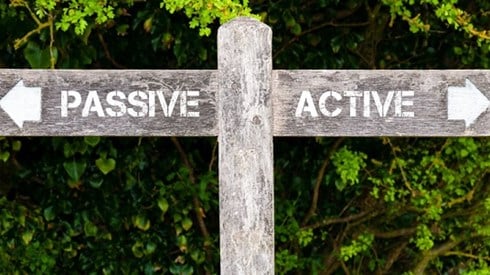Captives: Is Passive or Active Investing a Better Strategy?

February 01, 2021

It's been several years since we explored this debate. For those wishing to see what we had argued in the past, you can find the articles below. The conundrum between a captive insurance company choosing a passive investment strategy versus an actively managed strategy has always existed.
Back when I began my professional career, the pendulum was firmly pegged over on the active side of the arc. It also coincided with the high-water mark for professional investment management fees. Obviously, a lot has changed in the intervening 40 years. So today, which option—passive or active—makes the most sense for a captive?
Just for clarity's sake, let's define what we mean when we use the terms "passive" and "active." Active investing typically involves the use of a portfolio manager, surrounded by a team of specialists including credit analysts, modeling, and macroeconomic experts. The portfolio manager takes advice from all these individuals and creates a portfolio of investments that should match your desired risk/reward parameters.
The purpose of an active strategy is really two-fold: one, to create so-called alpha, or a return greater than the market as a whole would produce, and, two, to construct the portfolio to limit downside risk so that when the market declines your portfolio performs better than the market as a whole.
Active managers expect to get compensated for this process, and therefore, their fees are commensurately higher than fees for a passive investment strategy. Theoretically, the fees charged by the manager should be more than offset by the "alpha" they generate above the market, or when markets fall by limiting the damage to the portfolio resulting in a smaller loss.
Passive investing is built on the premise that over the long term, active managers cannot outperform the market, and therefore, you are better to accept the return the market provides. The tradeoff is fees for passive investing are lower than for active investing. While the expectation is you will never achieve the market return after fees when using passive investing, over time this strategy produces superior results compared to an actively managed portfolio.
Are there any guidelines that a captive insurer could use in determining which option might be better for its portfolio? The short answer is yes, although they are not universally accepted. In exploring these, we are going to make a basic assumption, that most captives hold a higher percentage of their portfolio in fixed-income securities rather than equities or more exotic assets.
Level of Interest Rates
Interest rates determine the book yield on an investment portfolio. Active management fees have always been higher than passive management fees. That difference is easier to overlook when interest rates are higher since the bite taken by active management fees is a smaller percentage of the book yield. Currently, we are in a very low interest rate environment, which, if you believe the experts, is likely to remain for an extended period of time.
Advantage: Passive strategy
Market Volatility
When markets are behaving erratically, investors tend to fail to differentiate between strong issuers and weaker issuers, leading to a flight to quality. For passive investors, since you "own" the market, you get to go along for the ride, including the liquidation of assets needed to meet redemptions. This can result in unanticipated realized losses in the portfolio. Active portfolios may escape this damage due to sector and security selection.
Advantage: Active strategy
Market Size
Typically, the larger the size of the overall market, the more efficient the market is. By efficient, we mean the difference between the bid-ask spread for a specific security. Bid-ask represents the difference between the price a security dealer can buy a security for and what it can sell it for. The wider the bid-ask spread, the more frictional costs involved when trading the market. US Treasuries are seen as the most efficient of the fixed-income markets.
But size can also have a downside when using a passive strategy in fixed income. Passive investment strategies rely on replicating the market; the larger the number of securities within that market, the more securities a passive strategy needs to hold to be sure of mirroring the benchmark. Using the US Treasury market again, that can be thousands of different bonds. Therefore, even passive managers have to make choices in terms of which bonds they include in their portfolio.
Advantage: Toss-up, with passive strategies being preferred for larger, more liquid markets and active strategies being favored for smaller, more illiquid markets
Risk Management
Because a passive strategy holds the market, the ability to exit specific securities or sectors if their risk profiles get too different from the investors is nonexistent. The only option is selling the entire holding.
Advantage: Active strategy
Tax Efficiency or Tax Management
By tax efficiency, we mean gains and losses resulting from sales within the portfolio. Since a passive investment strategy relies on a buy and hold premise, there is less chance of a surprise. Conversely, an active strategy allows for investors to specifically choose which securities to sell and when, thus creating better tax management.
Advantage: Toss-up, depending on which is more important to your captive insurance company
Which strategy should your captive insurance company employ? While it may appear that active management has the edge based on the analysis above, it really comes down to how each captive weighs the importance of each of these factors. Additionally, each captive's asset allocation will differ, which may be an argument for one strategy over the other, or in some instances, a combination of the two.
February 01, 2021



